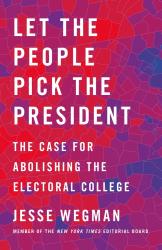We welcome your reviews of books that • were published within the past three years • do not advocate for a political party or politician • do address issues supported by the League, and • intrigued you enough that you want to share them. Please submit your review at any time to Margan and Thad Zajdowicz (Margan.Zajdowicz [at] gmail.com ()).
Let the People Pick the President
The Case for Abolishing the Electoral College
By Jesse Wegman

Since 1970, the League of Women Voters has taken a position supporting the direct election of the president of the United States. That’s fifty years—half the existence of the League. Jesse Wegman’s book describes how the Electoral College arose and presents dialogue between a supporter of direct presidential election and an imagined skeptic of the process. Along the way, we meet people whose names we know (James Madison, Alexander Hamilton, and George Washington) and others who aren’t familiar (James Wilson and John Koza).
At the Constitutional Convention, one of the hardest problems for delegates to solve was how to elect the president. The summer of 1787 was hot and humid in Philadelphia and the numerous debates over this issue were contentious, sweaty, and difficult. With time running out, a small group of delegates cobbled together the idea that electors from each state, equaling the total of their congressional delegation, would elect the president. It was a horrible solution. One wonders whether, if Independence Hall had been air-conditioned in 1787, this outcome might have been avoided.
The fundamental problem in 1787 was our original sin: slavery. The slaveholding states got their wish to count each slave as three-fifths of a person for the Census, which gave them enormous political power into the future. The Electoral College first foundered in the election of 1796, when John Adams (a Federalist) was elected president and Thomas Jefferson (a Democratic-Republican) became vice president because they were the winner and runner-up. They were bitter rivals. The third presidential election in 1800 was a total disaster, thrown into the House of Representatives for decision and resolved in Jefferson’s favor because of the power of the slaveholding states. The Twelfth Amendment in 1803—the only successful change to the Electoral College to date—stipulated that the electors would vote for a ticket of president and vice president on separate ballots.
There have been more than seven hundred attempts to undo the Electoral College. The most nearly successful was Indiana senator Birch Bayh’s attempt in 1970 to amend the Constitution. It failed. The echoes of slavery and white supremacy drove its demise. The final part of the book discusses the National Popular Vote Interstate Compact, which California supports. The compact would require states in the compact to award their electoral votes to the winner of the popular vote in the nation.
Every League member should familiarize him- or herself with the many good points that Wegman presents regarding the merits of a presidential popular vote, the compact, and the myths that surround the Electoral College. While a constitutional amendment would be the best way to effect the election of the president by popular vote, the National Popular Vote Interstate Compact is already close to being a reality. There is more work to be done. As League members, you should read this book to inform your discussions with people on the opposing side of this argument. And, by the way, you will learn how the phrase “We the People” came to be—wonderful for those, like me, who love trivia!
—Thad Zajdowicz, Co-chair, Healthcare Committee